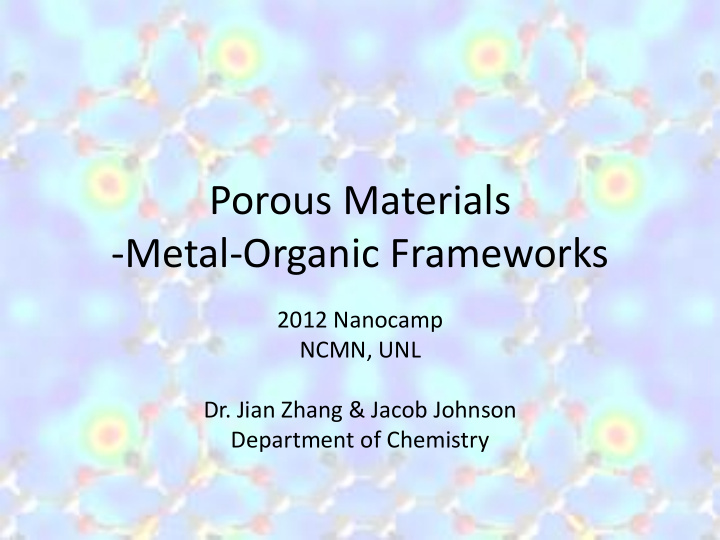



Porous Materials -Metal-Organic Frameworks 2012 Nanocamp NCMN, UNL Dr. Jian Zhang & Jacob Johnson Department of Chemistry
What does a chemist do? • Chemists observe and study • Chemists study the composition, assembly, properties, and reactivity of matter (atoms, molecules, materials) • Chemistry is considered as the central science
Chemistry is the Central Science Biology Pharmaceutical Medicine Astronomy Geology Chemistry Environmental Materials Science Physics Sciences
What does a chemist do? • Chemists make compounds and materials – Synthetic chemistry • Measure properties of materials Penicillin – Analytical chemistry • Model chemical reactions and materials structures – Theoretical and computational chemistry
What does it take to become a chemist? • Strong interest in science • Strong academic performance • 4+ years of college • Graduate degree (2-4 years) – Hundreds of graduate schools in the US • Diverse and rewarding career – Creativity is important – Worldwide industry – Work on important global problems • Energy • Pollution • Disease
The Zhang’s Group Research Metal-organic Frameworks Covalent-organic Frameworks Porous polymer networks
Lungs Bone Coral Soil Porous Materials in Nature Sandstones Butterfly Wings Snow Sea Sponge Egg Shells Lemons
Paper Clothing Chalk Brick Artificial Porous Materials Concrete Insulation Ceramics Cake Bread Sponges
Pore Type (size) Mesopores (2-50 nm) Macropores (< 50 nm) Micropores (< 2 nm) Surface of a chicken egg shell Carbon membrane Monolithic column
Microporous Materials • A microporous material is a material containing pores with diameters less than 2 nm • Activated Carbons • Zeolites • Metal-organic frameworks • Covalent organic frameworks • Microporous polymer
Applications – Microporous materials • Activated carbons – The small size of their pores gives them great surface area… they can adsorb a large amount of gas directly on to their surface. Popular support for some catalyst metals (especially palladium and platinum). ρ ~ 2g/cm 3 • Zeolites – The narrow size distribution of their pores makes them very useful for gas separation. Also used as catalysts because of acid sites in the pores. ρ ~ 4g/cm 3 • Metal organic frameworks – Their huge surface area and pore volume makes them potentially useful for gas sequestration/storage. ρ < 0.5g/cm 3
Activated Carbons Made from a variety of materials: Rice Husk Nut Shells Coconut Fiber Biomass Organic, non-ordered structure
Zeolites – Micropores are part of their crystal structure: • Most are synthetic • Alumino-silicates • Silicalite = no aluminum • Cation can be H + , Na + , Ca 2+ , NH 4 + , etc • Pore shape needs to be incorporated into pore size calculation for accurate results • Some adsorbates are better than others Inorganic, ordered structure
Metal Organic Frameworks MOFs Inorganic-Organic Hybrid, ordered structure – Synthetic materials – Also called coordination polymers – Similar materials without metals are called COFs… covalent coordination polymers – Still a very active research area
Metal Organic Frameworks MOFs Zn 4 O tetrahedra (blue) are joined by organic linkers (O, red, C, black), giving an extended 3D cubic framework with inter- connected pores of 11.2 Å aperture width and 18.5Å pore (yellow sphere) diameter
Metal Organic Frameworks MOFs
Breathable MOFs
Hydrogen Storage in Nano-Porous Materials Hydrogen storage • Petroleum dependence → U.S. imports 55% of its oil expected to grow to 68% in 2025 • Hydrogen as energy carrier → clean, efficient, and can be derived from domestic resources Renewable Fossil fuels Nuclear Energy (biomass, hydro, wind, solar, and geothermal) (coal ,natural gas, etc.)
Hydrogen Storage in Nano-Porous Materials Hydrogen storage • Hydrogen storage is a critical enabling technology for the acceptance of hydrogen powered vehicles • Storing sufficient hydrogen on board to meet consumers requirements (eg. driving range, cost, safety, and performance) is a crucial technical parameter • No approach currently exists that meets technical requirement. (driving range > 300 miles) • U.S. DoE → develop on board storage systems achieving 6 and 9 wt% for 2010 and 2015
Current Challenges with H 2 Storage Options Compressed Hydrogen -High pressure (500-700 atm), -Expensive storage container Liquid Hydrogen -Expensive cooling system required -High energy cost to liquefy H 2 Complex and Metal Hydrides -Poor reversibility -Require high temperature and pressure (>100 ˚C and >100 atm)
MOFs as hydrogen storage materials ~ 3% wt @ 77 K, 1 atm
CO 2 Sequestration
MOFs as CO 2 storage materials 38.5 wt% @ 273 K, 1 atm
MOF Construction Mn 2+ Organic Linkers Metal Nodes
120° 90° 90° 109.5° Tetrahedral Octahedral Trigonal Bipyrimidal
Recommend
More recommend